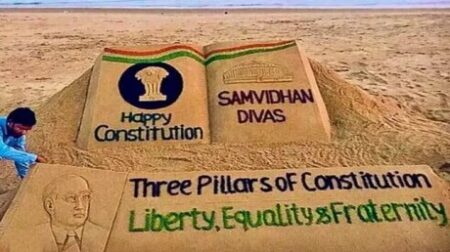In Punjab, groups and interests have formed around two parties: the Shiromani Akali Dal (SAD), founded as an openly religious party representing the rural Sikh class, and the Congress, which has roots in a variety of socioeconomic groupings, including the state’s Hindus.
Identity-based vote banks become less visible in the debate as one proceeds from Uttar Pradesh to Punjab. “Yaha to chahe takdi hai, chahe jhadu wale, ya panja-sabko vote milta hai,” a shopkeeper from Dera Bassi, just outside Chandigarh, says (scale, broom, hand—everyone gets votes in Punjab).
His most visible political identification is not based on caste or religion but rather on political party. He self-identifies as a “Congressi.” This is not to dismiss the significance of identity-based determinants in party selection but rather to highlight how partying is frequently divorced from social identity in Punjab. This also has an impact on how voters are mobilized on the ground.
Nonetheless, the amorphous nature of party loyalty has opened the door for the Aam Aadmi Party (AAP) this time around.

Model of Party Democracy
Groups and interests in Punjab have formed around two parties: the Shiromani Akali Dal (SAD), an essentially religious party representing the rural Sikh elite, and the Congress, which has roots across various groups, including the state’s Hindus.
Power frequently shifted between the two parties, generating what political scientist Bernard Manin refers to as “party democracy,” People vote for the party regardless of the individual.
In other words, many voters base their decisions on partisanship rather than personal devotion to the top leader, as seen by their support for parties like the Trinamool Congress (TMC) or the Telangana Rashtra Samithi (TRS).
This is evident in how three-time chief minister Amarinder Singh has been relegated to a minor role following his expulsion from Congress.
However, in the previous two decades, the functions of the party and the state have grown nearly identical. The Akali dictatorship operated buses, baked bread, and broadcast television networks, among other suspected unlawful enterprises, which clearly demonstrated this merger.
Similarly, there was slight variation in the stances espoused by these groups on critical subjects like the drug crisis or “beadbi” (sacrilege).
Individual candidates were exceptionally influential as Congress and the SAD built separate patronage structures, directly invested in promoting their enterprises, and outsourced significant public goods to friends and family.
The blurring of the party-state barrier has made it increasingly difficult to maintain the political bond that connects society and the state.
“The Congress candidate is not an MLA, but he has done a lot of work.” Interlocked tiles have been installed on all village roadways. “The Congress will lose Punjab, but he is in a strong position,” an Aam Aadmi Party (AAP) worker at a party booth in the Dakha assembly district said (AC).
This strategy of reliance on individual candidates’ support and their pure patronage networks is average for SAD and Congress. This can also alter voters’ strategic motivations since they may vote for a candidate even if their party has little prospect of establishing a government.
A Distinctive Kind of Party
The ascendant AAP looks utterly different from the traditional parties; its only recognizable faces are CM aspirant Bhagwant Mann and party chief Arvind Kejriwal.
A young man in a village in Gidderbaha, AC, says, “I think the candidate for AAP might be a local, but no one has ever heard of him.” When we ask about his interactions with the party, he says, “I’ve never seen a party worker from AAP here.” We get all of our information about them from Facebook.
If this election followed what we see on Facebook, 80% of the electorate would vote for AAP. “The young man also makes it clear that this time he will be switching his vote from Congress to AAP.
All across Punjab, from supporters and detractors alike, no one seems to mention the names of AAP’s candidates, only jhadu (broom) — AAP’s party symbol.
In 2017, AAP dismantled its state unit following a poor performance rather than invest more. Its most recognizable faces, like H.S. Phoolka, either departed or were shoved out.
Whether intentional or not, the shortage of recognized local figures has made it harder for AAP’s opponents to associate the party with local corruption or extreme “pro-Khalistan” individuals — a ploy that terrified primarily urban Hindu voters in Punjab the last time around.
Dakha, an AAP volunteer in Phoolka’s previous constituency, detects a wave of enthusiasm for the party but is skeptical that it can turn this into votes given its inadequate organization. He says, “We won’t have a party structure until we establish the government.”
This time, the results will be determined by the trade-off between voter preferences and organizational strength.
Published By: Jaspreet Singh
Edited By: Kritika Kashyap












